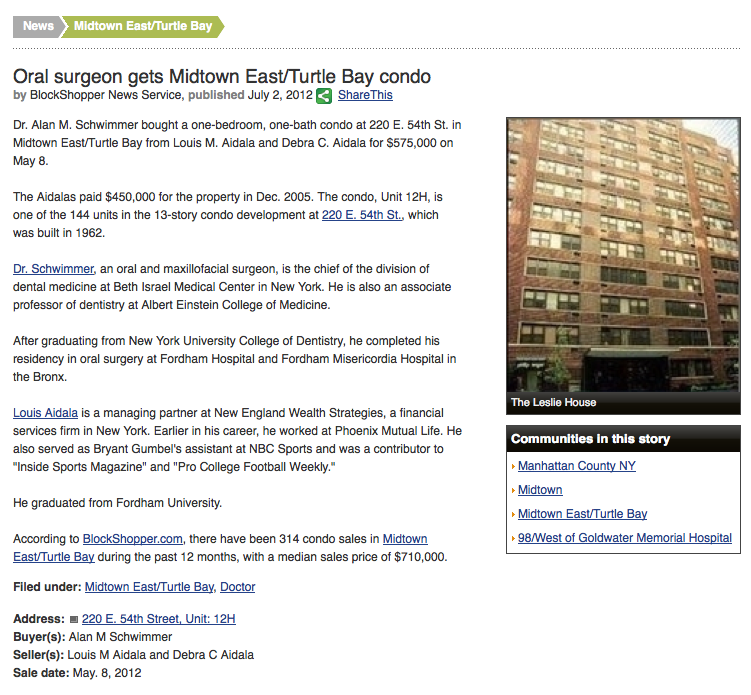The New York Times quietly announced that it was ending its three-year-old experimentation with hyperlocal journalism, and on its heels, the Neiman Journalism Lab wrote a piece following up with some of the players and laying out five specific lessons learned. These lessons are:
1. It just doesn’t make sense for big media companies to pay their staffs to go hyperlocal.
2. Hard-hitting hyperlocal coverage benefits from some professional journalism.
3. Create a platform that makes it easy for people to participate in diverse ways.
4. Understand the power of email.
5. Don’t abandon experiments in “innovation land.”
Hyperlocal — which I define as small-time stories that are confined to a geographic area but which are incredibly important to that area — is a serious puzzle, one that no one has found a good solution for yet. When hyperlocal had buzz — probably back two or three years ago now, when it wasn’t yet clear that it was such a quagmire — the indicators were that as papers were shutting down left and right, folks needed an online equivalent for news and such. The argument was that print papers were closing down because their “business model” — which is to say, putting interesting and germane copy around relevant ads — was failing, but online news would somehow be the answer. For some unknown reason, but probably because it was much, much cheaper, the people running these new hyperlocal startups (or sometimes online versions of existing papers) also convinced themselves that, in addition to going online instead of print, they would also do it on the cheap: Instead of paying experienced beat reporters to do good ol’ writing about the day’s local news, a model that had worked forever, they would instead fired those people, “engage the community” and hire “citizen journalists.” In retrospect, that didn’t work so well.
According to the Times‘s Jim Schachter, it turns out it’s “impractical” for the New York Times, being a national and international news org, to turn to hyperlocal coverage. Well, yeah. Despite the fact that the Times itself has a well-read City Desk (read: hyperlocal news), it’s not their model to start an equivalent in Wherever Else, USA. They know New York City. They have a giant, well-recognized brand in which local places want to place their trust and their ads. It’s a good combination — it’s a business, in fact! — called “the news media.” It’s “scalable” in that it works (or used to) in almost every community across the world.
Another now-obvious hyperlocal lesson learned: Professional journalists are good at writing and editing. Non-journalism-skilled “citizens” aren’t necessarily good at that stuff. Extrapolating, when readers want information, they want it to be relevant and clear. They don’t want to have to work for it. When these waters are muddied — trying to parse what a non-journalist is trying to say among possibly irrelevant, definitely badly written prose — it is not a fun time. Readers’ response to this isn’t to get even more engaged and volunteer to be the citizen journalist, much as the bottom-liners at media companies wish they would. It’s not even that they get riled up and want to comment about the quality. What readers do is, they just stop reading.
The thing is, though: People care deeply about and do want to read about local news. They care about school board meetings and and city council decisions and high school sports scores and local heroes. They just don’t want to go to the board meetings or ball games themselves. They don’t care that much. Plus, they’re busy doing their own jobs.
So these are two key realizations of the hyperlocal business: You have to provide relevant and well-written copy that doesn’t ask anything of the readers other than to read. (And maybe, if it’s well-written and relevant enough, they might actually pay for the privilege and/or comment on a story.)
Another essential understanding is recognizing and respecting a corollary phenomenon: the rise of social media as a determiner of local relevancy. The Neiman article doesn’t touch on it at its own embarrassment, since engagement is this area is absolutely insane, off-the-charts, disruptive, phenomenal, revolutionary, whatever word or phrase that means a new paradigm has been created. That a new paradigm for social interaction occurred simultaneously yet oppositionally with the attempt at a new paradigm for local news is a coincidental but unfortunate event (unfortunate, that is, for these news sites).
My understanding of the fourth finding, “Understand the power of email” is that people like newsletters. But in my experience this is neither true nor relevant. However, the third lesson, the idea that technology must facilitate participation, is huge, and it’s another key point to answering the question that Schachter proposes: “How do you prompt communities into the act of covering themselves in a meaningful way?” I don’t have the answer (does anyone?), but I think social is playing no small part in this, too, and one need only see all the check-ins and status updates to see that people do like participating in the community around them (and, in turn, telling others about it in order to either humble-brag or exacerbate their followers’ FOMO or both).
I almost want to (badly) paraphrase Mean Girls by saying, “Stop trying to make hyperlocal happen.” But actually, I do think hyperlocal has a place in our evolving news, online and social ecosystem. Hell, I think algorithms have a place. It’s early days yet. But it seems to me that what successful products have in common, and what they all come to realize sooner or later, is that above all else, they must serve the reader (or user). It’s so incredibly obvious yet so often overlooked. And as soon as hyperlocal sites incorporate this truth into their businesses, the better the experience will be for readers and the online news industry at large.
Read More

